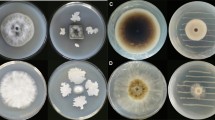Summary
The antifungal activity of volatile oil obtained from the leaves of sweet gale (Myrica gale) has been investigated. Fungi, isolated from the leaves ofM. gale, were grown in liquid medium containing the oil and its effect on biomass production was gauged. The oil inhibited growth of all species of fungi to greater or lesser extent. Sesquiterpenes were more active than monoterpenes, and among the sesquiterpenes germacrone was marginally more active than β-elemenone. These results support the proposition that the volatile oil ofM. gale has a role in resistance to fungal pathogens.
Similar content being viewed by others
References
Annila E, Hiltunen R (1977) Damage byPissodes validivostris (Coleoptera, Curculionidae) studied in relation to the monoterpene composition in Scots pine and lodgepole pine. A Entomol Fenn 43:87–92
Arsvoll K (1975) Fungi causing winter damage on cultivated grasses in Norway. Meldinger fra Norges Landbrukshogskole. 54:49
Behre K-E (1983) Aspects of the history of beer flavouring agents based on fruit finds and written sources. In: (eds. W van Zeist & W Casparie) Plants and Ancient Man: Studies in Palaeoethnobotany. Rotterdam, Netherlands: Balkema. pp 115–122
Bloomfield B, Alexander M (1967) Melanins and resistance of fungi to lysis. J Bacter 93:1276–1280
Booth C (1971) The GenusFusarium. Kew: Commonwealth Mycological Institute. pp 86–87
Bull AT (1970) Inhibition of polysaccharases by melanin: enzyme inhibition in relation to mycolysis. Arch Biochem Biophys 137:345–356
Carlton RR, Waterman PG, Gray AI (1992) Variation of leaf gland volatile oil within a population of sweet gale (Myrica gale) (Myricaceae). Chemoecology 3:45–54
Cates RG, Redak RA (1986) Between-year population variation in resistance of Douglas-fir to the western spruce budworm. Pp 106–117in Green MB, Hedin PA (eds) Natural Resistance of Plants to Pests. Washington: Am Chem Soc
Cates RG, Henderson CB, Redak RA (1987) Responses of the western spruce budworm to varying levels of nitrogen and terpenes. Oecologia (Berlin) 73:312–316
Clapham AR, Tutin TG, Moore DM (1987) Flora of the British Isles. 3rd ed. Cambridge: Cambridge University Press
Deans SG, Ritchie GA (1987) Antibacterial properties of plant essential oils. Intern J Food Microbiol 5:165–180
Domsch KH, Gams W, Anderson T-H (1980) Compendium of Soil Fungi. London: Academic Press
Elliott S, Loudon A (1987) Effects of monoterpene odors on food selection by red deer calves (Cervus elaphus). J Chem Ecol 13:1343–1349
Foister CE (1930) A note on a rare parasitic fungus onMyrica gale L.Ovularia destructiva (Phil. & Plow.) Massee. T Proc Bot Soc Edin 30:244–245
Grove WB (1935) British Stem and leaf Fungi. Vol. 1. Cambridge: Cambridge University Press
Jackson J (1977) The annual diet of the fallow deer (Dama dama) in the New Forest, Hampshire. J Zool 181:465–473
Langenheim JH, Foster CE, McGinley RB (1980) Inhibitory effects of different quantitative compositions ofHymenaea leaf resins on a generalist herbivoreSpodoptera exigua. Biochem Syst Ecol 8:385–396
Lindlöf B, Lindstrom E, Pehrson A (1974) Nutrient content in relation to food preferred by mountain hare. J Wildl Man 38:875–879
Malterud KE (1982) Sweet gale — in brewing beer, witch expulsion and natural products chemistry. Brygmesteren 39:45–55
Malterud KE, Faergi A (1982) Bacteriostatic and fungistatic activity of C-methylated dihydrochalcones from the fruits ofMyrica gale L. A Pharm Suec 19:43–46
Maruzzella JC (1962) Germicidal properties of perfume oils and perfumary chemicals. Am Perf 77:67
Maruzzella JC (1963a) Antifungal properties of perfume oils. J Pharm Sci 52:601–602
Maruzzella JC (1963b) An investigation of the antimicrobial properties of absolutes. Am Perf 78:19
Maruzzella JC, Reine S, Solat H, Zeitlin A (1963) The action of essential oils on phytopathogenic bacteria. Plant Disease Rep 47:23–26
McDowall PG, Lwande W, Deans SG, Waterman PG (1988) The volatile resin exudate from the stem bark ofCommiphora rostrata: potential role in plant defence. Phytochemistry 27:2519–2521
Mihaliak CA, Couvet D, Lincoln DE (1987) Inhibition of feeding by a generalist insect due to increased volatile leaf terpenes under nitrate limiting conditions. J Chem Ecol 13:2059–2067
Morin PH, Caude M, Richard H, Rosset R (1986) Semipreparative separation of terpenoids from essential oils by high-performance liquid chromatography and their subsequent identification by gas chromatography-mass spectrometry. J Chromat 363:57–69
Morris JA, Khettry A, Seitz EW (1978) Antimicrobial activity of aroma chemicals and essential oils. J Am Oil Chem Soc 56:595–603
Nagy JB, Tengerdy RP (1968) Antibacterial action of essential oils ofArtemesia as an ecologic factor. II. Antibacterial action of the volatile oils ofA. tridentata (big sagebrush) on bacteria from the rumen of male deer. Appl Microbiol 16:441–444
Oh HK, Sakai T, Jones MB, Longhurst WM (1967) Effect of various essential oils isolated from Douglas Fir needles upon sheep and deer rumen microbial activity. Appl Microbiol 15:777–784
Oh HK, Jones MB, Longhurst WM (1968) Comparison of rumen microbial inhibition resulting from various essential oils isolated from relatively unpalatable plant species. Appl Microbiol 16:39–44
Reichardt PB, Anderson BJ, Clausen TP, Hoskins LC (1989) Thermal instability of germacrone: implications for gas chromatographic analysis of thermally unstable analytes. J Chem Ecol 67:1174–1177
Scholl JP, Kelsey RG, Shakizadeh F (1977) Involvement of volatile compounds ofArtemisia in browse preference by mule deer. Biochem Syst Ecol 5:291–295
Small E (1972) Ecological significance of four critical elements in plants of raised sphagnum peat bogs. Ecology 53:489–503
Stipanovic RD (1983) Function and chemistry of plant trichomes and glands in insect resistance: protective chemicals in plant epidermal glands and appendages. Pp 69–102in Hedin PA (ed.) Plant Resistance to Insects. Washington: Am Chem Soc
Vanderplank JE (1984) Disease Resistance in Plants. 2nd ed. London: Academic Press
Author information
Authors and Affiliations
Rights and permissions
About this article
Cite this article
Carlton, R.R., Waterman, P.G., Gray, A.I. et al. The antifungal activity of the leaf gland volatile oil of sweet gale (Myrica gale) (Myricaceae). Chemoecology 3, 55–59 (1992). https://doi.org/10.1007/BF01261457
Received:
Accepted:
Issue Date:
DOI: https://doi.org/10.1007/BF01261457




